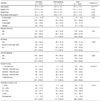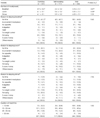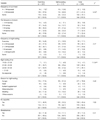Abstract
The purpose of this study was to examine food habits and dietary behavior related to using processed food among male college students residing in dormitory and self-boarding in Gangwon. A total of 344 students (dormitory group: 227, self-boarding group: 117) were surveyed from May to June of 2012. The results are summarized as follows: self-boarding group had a significantly higher frequency of skipping breakfast and lunch and frequency of out meal compared with the dormitory group (p < 0.05, p < 0.05, p < 0.05 respectively). The self-boarding group had a significantly lower the score of 'eat vegetables and Kimchi at every meal' (p < 0.001) and 'eat a variety of food everyday' (p < 0.001) compared with the dormitory group. The self-boarding group had a significantly higher the preference for meat products (p < 0.05) and canned food (p < 0.01) for selecting processed food compared with the dormitory group. The consideration for selecting processed food was ranked by 'taste', 'price', 'expiration', 'appearance' and 'nutrition' in both dormitory and the self-boarding group. In the dormitory group, nutrition labels were identified certainly 2.6%, sometimes 12.8%, and rarely 17.2%. In the self-boarding group, nutrition labels were identified certainly 1.7%, sometimes 18.0%, and rarely 24.8%. The necessity of nutrition education was high in both dormitory group (51.6%) and the self-boarding group (62.4%). Therefore, development of an educational program and application of the information from nutrition labels for male college students, especially self-boarding students will be effective in improving dietary life in order to maintain healthy dietary habits.
Figures and Tables
References
1. Bae YJ, Lee JC, Kim MH. Nutritioal status and dietary quality of college students by residing types in Samcheok. J Korean Diet Assoc. 2007; 13(4):311–330.
2. Bae YJ, Yeon JY. Dietary behaviors, processed food preferences and awareness levels of nutrition labels among female university students living in middle region by breakfast eating. J Korean Diet Assoc. 2011; 17(4):387–402.
3. Bolton-Smith C, Casey CE, Gey KF, Smith WC, Tunstall-Pedoe H. Antioxidant vitamin intakes assessed using a food-frequency questionnaire: correlation with biochemical status in smokers and non-smokers. Br J Nutr. 1991; 65(3):337–346.
4. Brevard PB, Ricketts CD. Residence of college students affects dietary intake, physical activity, and serum lipid levels. J Am Diet Assoc. 1996; 96(1):35–38.
5. Chang YK, Oh EJ, Sun YS. A study on the food habit & the health responses of college students to the todai health index. J Korean Home Econ Assoc. 1988; 26(3):43–51.
6. Choi JG, Shin MK, Seo ES. A study on self-evaluated obesity and food habits by residence type of college students in Ik-San area. J Korean Living Sci Assoc. 2004; 13(1):97–110.
7. Choi KS, Shin KO, Huh SM, Chung KH. Comparison of nutritional and physical status according to the residental type among college women in Seoul women's university and Sahmyook university. Korean J Nutr. 2010; 43(1):86–96.
8. Choi MK, Jun YS, Park MK. A study on eating patterns and nutrient intakes of college students by residences of self-boarding and home with parents in Chungnam. J Korean Diet Assoc. 2000; 6(1):9–16.
9. Han MJ, Cho HA. Dietary habit and perceived stress of college students in Seoul area. Korean J Diet Cult. 1998; 13(4):317–326.
10. Hwang JH, Lee HM. A study on lifestyles, dietary habits, nutrition knowledge and dietary behaviors of male university students according to residence type. Korean J Community Nutr. 2007; 12(4):381–395.
11. Jun YS, Choi MK, Kim MH. The effects of alcohol intake on nutritional intake status of college students in Chungnam. J Korean Diet Assoc. 2002; 8(3):240–249.
12. Jung HW, Jung LH. A study on use of processed food for high school students in Gwangju. Korean J Hum Ecol. 2008; 11(1):21–33.
13. Kim KH. A study of the dietary habits, the nutritional knowledge and the consumption patterns of convenience foods of university students in the Gwangiu area. Korean J Community Nutr. 2003; 8(2):181–191.
14. Kim MH, Jeong ES, Kim EJ, Chol HK, Bae YJ, Choi MK. Night eating status of university students in partial area of Chungnam. J East Asian Soc Diet Life. 2011; 21:563–576.
15. Kim K, Lee MJ, Kim JH, Shim YH. A study on weight control attempt and related factors among college female students. Korean J Community Nutr. 1998; 3(1):21–33.
16. Kim MH, Lee JC, Bae YS, Cho HK, Kim MH, Kim EY, Hong WJ, Sung SJ. Nutritional status and diet quality of female college students by living together with or without parents. J East Asian Soc Diet Life. 2006; 16(6):635–645.
17. Kim MS. A study on the eating behavior of the university students by type of residence in Taebaek city. J Korean Home Econ Assoc. 2004; 42(10):1–10.
18. Kim WY, Cho MS, Lee HS. Development and validation of mini dietary assessment index for Koreans. Korean J Nutr. 2003; 36(1):83–92.
19. Klesges RC, Eck LH, Isbell TR, Fulliton W, Hanson CL. Smoking status: effects on the dietary intake, physical activity, and body fat of adult men. Am J Clin Nutr. 1990; 51(5):784–789.
20. Korea Health Statistics [KHS]. Korea National Health and Nutrition Examination Survey (KNHANES V-2)(2011). 2012. p. 366. p. 368. p. 370. p. 387. p. 391.
21. Lee EJ. The effect of the middle school home economics curriculum on the students's perception of nutrition labels and their choice of processed food. Seoul, Korea: Dongguk University;2008. MS Thesis.
22. Lee HS, Lee JA, Paik JJ. A study of food habits, physical status and related factors of college students in Chuncheon. Korean J Community Nutr. 1998; 3(1):34–43.
23. Lee IS, Choi BS, You DR, Park YM. College students characteristics and utilization of the nutrition labels on food package. Korean J Diet Cult. 2002; 17(3):299–308.
24. Lee MS, Woo MK. Changes in food habit, nutrition knowledge and nutrition attitude of university students during nutrition course. Korean J Nutr. 1999; 32(6):739–745.
25. Lee KA, Cho EJ, Yoon HS. A study on consumption of convenience foods of university students by residing types in Changwon and Masan area. J Korean Diet Assoc. 2010; 16(3):279–290.
26. Lee KJ, Lee YH. Consumer's recognition and using state about food-nutrition labeling system among twenties. J East Asian Soc Diet Life. 2004; 14(1):54–63.
27. Lee YN, Choi HM. A study on the relationship between body mass index and the food habits of college students. Korean J Diet Cult. 1994; 9(1):1–10.
28. Lee YN, Lee JS, Ko YM, Woo JS, Kim BH, Choi HM. Study on the food habits of college students by residences. Korean J Community Nutr. 1996; 1(2):189–200.
29. Lim YS, Park HR, Han GJ. Comparison of preference for convenience and dietary attitude in college students by sex in Seoul and Kyunggi-do area. J Korean Diet Assoc. 2005; 11(1):11–20.
30. McPhillips JB, Eaton CB, Gans KM, Derby CA, Lasater TM, McKenney JL, Carleton RA. Dietary differences in smokers and nonsmokers from two southeastern New England communities. J Am Diet Assoc. 1994; 94(3):287–292.
31. Misra R. Knowledge, attitudes, and label use among college students. J Am Diet Assoc. 2007; 107(12):2130–2134.
32. Park SS, Kim NY, Han MJ. Processed food preferences and food and nutrition labeling perceptions of middle school students. Korean J Food Cookery Sci. 2008; 24(2):164–173.
33. Satia JA, Galanko JA, Neuhouser ML. Food nutrition label use is associated with demographic, behavioral, and psychosocial factors and dietary intake among African-Americans in North Carolina. J Am Diet Assoc. 2005; 105(3):392–402.
34. The Korea National Statistical Office. Annual report on the cause of death statistics: based on vital registration. 2006.
35. Ryu ES. The study on the dietary behavior of university students in Busan area. Korean J Diet Cult. 1993; 8(1):43–54.
36. Yang J, Shon CM. Nutritional status and dietary quality by their residing types in college students. J Korean Living Sci Assoc. 2009; 18(4):959–970.




 PDF
PDF ePub
ePub Citation
Citation Print
Print










 XML Download
XML Download